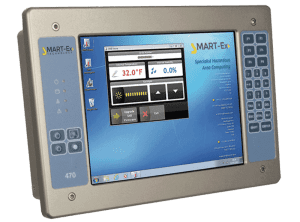At Zytronic we’re constantly reminding our customers, and potential customers, that touchscreens are everywhere, we can’t get away from them (not that we would want to!).
Portable touchscreen enabled devices such as smart phones and tablets are now common place, and they’ve allowed us to be more connected and efficient in our personal and professional lives, keeping in touch with colleagues and friends, shopping and browsing the internet, all while on the move. But have you ever stopped to appreciate just how effective touch screen devices in the work place could be? Could touchscreens make our working lives easier?
Industrial Control
Human Machine Interfaces (HMI’s) found in factories, mining, and outdoor industrial work areas have a tough life. Extreme weather conditions, surface contaminants and heavy use can rapidly wear out mechanical dials, buttons and levers. Their ‘fixed’ nature also limits their functionality. But the right touchscreen from Zytronic, can withstand even the most extreme environments offering a tough, waterproof, and hygienic solution that will detect a finger, conductive stylus and even a gloved hand, through glass thickness of 20mm or more.
Touch enabled HMI’s, create a durable solution for industrial control that need less up-keep and gives the worker access to more information via a flexible user interface design and ultimately creating a smarter working solution compared to traditional control systems.
Smart EX case study
Zytronic’s ZyTouch® and ZyBrid® products have been utilised by ‘mission critical’ process controls manufacturer Smart-Ex in their range of intrinsically safe (ATEX approved) terminals designed for use in potentially explosive atmospheres, such as mining, oil and gas drilling.

Due to the incredibly demanding working environment in which the terminals are deployed the touch sensors can be over 20mm thick, and it is essential that the touch technology is capable of faultless outdoor 24/7 operation, despite the presence of corrosive salt water and oil, whilst responding to the touches of users wearing heavy work gloves.
Touchscreen solutions based on conventional projective capacitance (p-cap) methods would be incapable of coping in such conditions , as they lack the sensitivity to determine touch events through more than one or two mm of front glass. However, Zytronic’s PCT™ touch sensor products are particularly suited to, and are proven in applications of this kind due to their unique construction and sensing method.
Medical
Touch screen technology is emerging as an invaluable tool for healthcare professionals and the treatment of sickness and disease. They provide an intuitive interface for medical testing equipment, that can quickly and accurately show results and be interrogated for data. If the right touch technology is selected, they provide a more hygienic solution compared to buttons, switches and dials, and can even be operated by medical staff wearing surgical gloves.
Case Study – Perimed
Zytronic touch sensors are also working hard to provide a smart and portable solution for a new Blood Analysis System by Perimed. The

Zytronic touchscreen that makes up the user interface of the transcutaneous oxygen monitoring equipment used in hospitals is a specially designed 8.7” ZyBrid® touchscreen.
“Our engineering team was greatly impressed with the attributes exhibited by Zytronic’s touch technology. By incorporating it into the PeriFlux 6000, we can have total confidence that this instrument will deliver high quality results consistently, with no compromise in performance” quoted Björn Bakken, President of Perimed.
The John Radcliffe Hospital located in Oxford UK, is also making excellent use of a giant touch enabled computer to study tumours. The interactive nature of the technology allows for groups of students to evaluate specimen images, using pinch and pull gestures to manipulate and zoom in high resolution images.
https://www.nds.ox.ac.uk/files/documents/giant-touchscreen-1845-29-2-lq.wmv (Dr Clare Verrill on BBC Oxford News demonstrating how to analyse a tumour using the giant touchscreen computer. The clip was aired on 26 February 2016)
Adapting touchscreen technology to research and medical applications can allow for better training and ease of access, working smarter to benefit trainee doctors and patients alike.
Office
Imagine having all the app and programs you need to do your job at the touch of your fingertips on an interactive touch screen desk. A responsive desk which connects to your handheld devices or your colleagues in a blink of an eye.
The iDesk is the vision of designer Adam Benton, who envisions a working office world where you have easy access to your to-do lists and post-it notes, your calendar or emails at your fingertips. The touchscreen desk could also be used for interactive presentations, creating an immersive experience for the whole team, and creating a smarter workplace.

(source)
The potential opportunities offered by this type of solution is exciting. Based on a touch table, featuring single, multitouch, and object recognition technology, this “iDesk” could fuel the office of the future. While we’ve not yet seen this desk brought to life, it does remind us of the predicted technology seen in early Sci-Fi novels and movies, many of which have been brought to life recently through advances in technology. Zytronic’s MPCT™ multitouch technology is certainly capable of producing the touch responses necessary for this type of application, so get in touch you want to try it out!
If you’d like to know more about how Zytronic can help you with your project, please contact us.